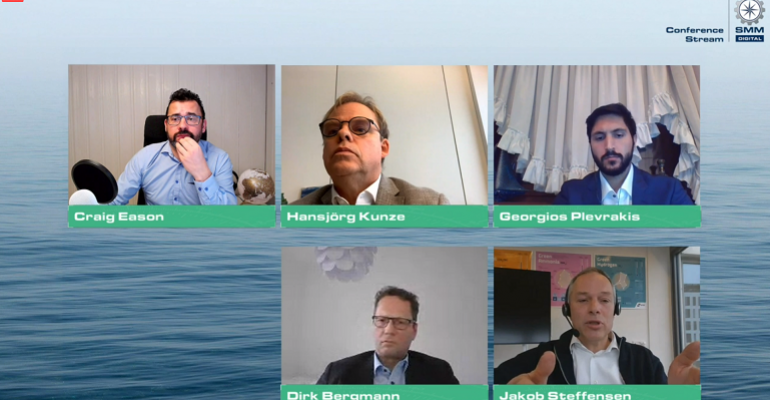DFDS Head of Innovation and Technology, Jakob Steffensen said methanol soon fell out of favour as a potential lower-carbon fuel once the company considered the wider industrial landscape.
“After discussing approaches with energy producers and other industries, we got really concerned about focussing on a fuel which needs to contain sustainable carbon. Industries like aviation and cement production, if society wants them to go green and sustainable, they are pretty much screwed without access to all of the sustainable carbon we can make,” said Steffensen.
“I think shipping needs to be really concerned about chasing a fuel that needs carbon, because we really don’t want to compete—with for instance aviation—on who is willing to pay the most for that sustainable fuel. Please look at the decarbonisation pathways of other industries in your country.”
Leaving methanol to industries in greater need, DFDS backs ammonia for its decarbonisation strategy. “Hydrogen and green ammonia production is very, very scalable; the more you use them, the cheaper they get,” said Steffensen, whereas he expects fuels with a green carbon content will become more expensive.
Producing green ammonia takes a large amount of electrical energy, but Steffensen sees a solution through collaborating with energy producers; ammonia production could use up excess electricity from renewable generation sources when output exceeds demand. Such a buffer system could help renewable electricity providers build a business case as that sector continues to expand, he said.
“Whenever we build new vessels we need to make sure they are zero emissions, or at least zero emissions ready. We believe that ammonia offers a very comfortable transition opportunity for a shipowner, because we can start out with a combustion engine setup very similar to today, change the fuel to ammonia, and then maybe 10-15 years down the line we can change to a solid oxide fuel setup,” said Steffensen.
Weighing the various pros and cons of different fuels, Hansjörg Kunze, VP Communication & Sustainability, AIDA Cruises said that the company had yet to find their perfect fuel solution, but in the meantime, it backed LNG, biofuels and e-fuels as bridging technologies that will be around for many years.
Planning for technologies needs to be done ahead of time and in some cases before the regulatory landscape is clear, said Kunze. With cruise ships typically lasting 25-30 years, there is little room to delay as IMO GHG emissions reduction targets are in place for 2050. Despite the tight timescale, AIDA Cruise plans to have an emissions-neutral ship by 2030 and aims to reach the IMO 2050 targets 10 years early.
As an example of a green leap of faith, there was a 12-year gap between AIDA Cruises ordering its first ship with the capability to take shore to ship power and actually using the technology to cold iron. Similarly, the company ordered dual-fuel LNG ships years before receiving the approvals it would need for bunkering LNG in port.
Dirk Bergmann, Chief Technical Officer, Turbocharging ABB Turbo Systems AG said that with the range of alternative fuels being explored, he was confident the industry would settle on a solution in the long run. For him, the critical period is the transition from where we are now—needing to limit the GHG emissions of the 100,000 or so vessels on the water—to widespread adoption of a zero-carbon solution.
Awareness of that imperative has grown, said Georgios Plevrakis, Director, Global Sustainability, ABS. He said his daily conversations with shipowners around sustainability quickly shifted last year from meeting IMO 2020 sulphur regulations to tackling decarbonisation. Owners seem to be aware that they cannot make business decisions without being part of these decarbonisation conversations, which include covering the topic with financiers and charterers, he said.
In the short term, shipowners have upcoming milestones that require immediate action, such as EEXI requirements in 2023, said Plevrakis. From there, owners need to build a fleet-wide strategy looking at the vessels that will be with them in 15-20 years, the vessels they use to replace their fleets over the next decade and those that will still be with them when 2050 comes around.
As shipowners realise their decarbonising plan, the technology sector is ramping up its efforts to meet the challenge.
Steffensen recalled a 2016 meeting of technical leaders from Danish shipping where talk of hydrogen, ammonia and zero emissions were met with stunned silence and negativity. “It has been inspiring to see how far we have got in these very few years. We’ve learned a lot and I actually think we can do this. Not all the existing players will be able to make the transition, but shipping can make the transition. Great opportunities lay ahead of us,” said Steffensen.
Copyright © 2024. All rights reserved. Seatrade, a trading name of Informa Markets (UK) Limited.
Add Seatrade Maritime News to your Google News feed.  |

